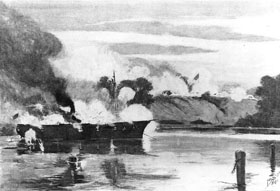Civil War Battles |
Colonial Wars |
American Wars |
Link To This Page — Contact Us —
The Battle of Fort Darling/Drewry's Bluff (First)
May 15, 1862 in Fort Darling, Virginia
 |
|||||||||||||||||||||
|
The Battle of Drewry’s Bluff was also known as the Battle of Fort Darling or Fort Drewry.
When the Confederate forces, under Gen. Joseph E. Johnston, withdrew from Yorktown on May 3, they exposed the port city of Norfolk to capture. If the Federals took Norfolk, the ironclad CSS Virginia would be helpless, without a port to use. To prevent the CSS Virginia's capture, its crew, led by Lt. John T. Wood, blew it up, destroying the only obstacle to the ascent of the James River by the Union navy. By mid-May, the Union ironclads USS Moniter and the USS Galena were leading 3 wooden warships up the James.
The Confederates agreed that their best chance to stop the Union ships from advancing on Richmond lay at a place called Drewry's Bluff. The site, officially known as Fort Darling, was owned by a man named Drewry. Since the military had all but ignored the fort until Yorktown was abandoned, the place was called Drewry's Bluff. There, about 7 miles below Richmond, the river is fairly narrow and the south bank is a sheer cliff 80-100 feet high.
After local farmers dug gun emplacements, President Jefferson Davis and his military advisor, Gen. Robert E. Lee, took action to shore up the position. Lee's oldest son, Brig. Gen. G.W.C. Lee, supervised the installation of heavy guns and the sinking of weighted hulks in the river channel as obstructions. Exceeding his advisory authority, R.E. Lee detached a brigade of infantry to support the position, and, with Wood in command, the crew of the Virginia took charge of the guns on the bluff. These preperations were hastily executed and makeshift; there was not any way to predict whether they would suffice when the union flotilla challenged Drewry's Bluff.
On May 15, at 7:45 A.M., the windows in Richmond, suddenly began rattling from the booming of large-caliber cannon. The 3 hour and 20 minute long battle that had just begun 8 miles down-river would decide which flag flew over Richmond that night.
Cmdr. John Rodgers had sailed his squadron of Union warships, including his ironclad flagship USS Galena, the famous ironclad USS Monitor, the ironclad USS Naugatuck, and wooden gunboats USS Aroostook and USS Port Royal. They sailed without incident from Hampton Roads to Drewry's Bluff, a 100 foot high cliff overlooking the river. Fort Darling on top of the bluff, along with an 8-gun Confederate battery, was the only obstacle preventing Rodgers from bringing Richmond under his guns. The fleet steamed up the James River to test the Richmond defenses.
They encountered submerged obstacles and deadly accurate fire from the batteries at Drewry's Bluff. The wooden gunboats had no chance of surviving under the plunging Confederate fire, so only the ironclads moved within range and opened fire. The USS Monitor found that its gun would not elevate enough to fire on the fort, and the USS Naugatuck's 100-pounder Parrot rifle burst halfway through the fight. The USS Galena, anchored broadside 600 yards from the bluff, was left to battle Fort Darling alone, and she bravely sat there absorbing terrible punishment. The Galena was hit repeatedly and 18 of the huge Confederate projectiles had penetrated her armor to explode inside or smash the wooden frame and bulwarks into splinters. Her crew sustained 24 killed or wounded. She had been set on fire and was leaking badly. She withdrew, badly crippled, only after expending all her ammunition.
The captain of the USS Port Royal had been wounded by a riverside sharpshooter. Even though she was hit a number of times, the USS Monitor suffered no damage and no casualties. All of the Union ships gave up the mission and retreated downriver. The Union Navy was turned back.
The Confederate gunners on the bluff, which included the USS Monitor's old anagonists from the CSS Virginia, cheered passionately for their victory and Richmond's salvation.
